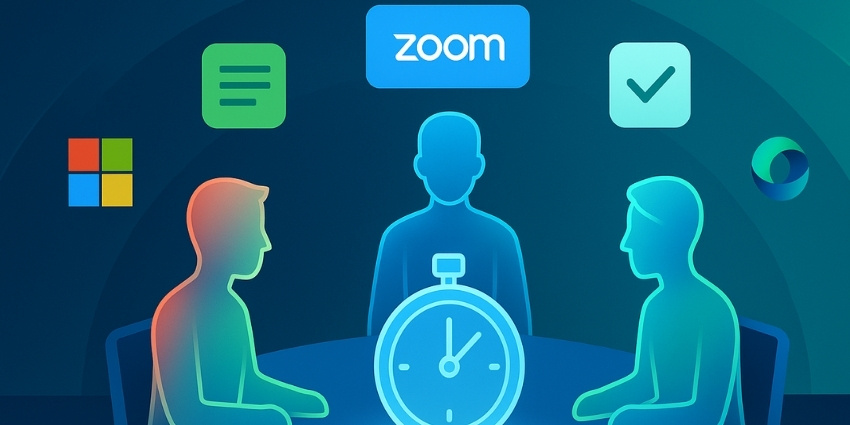From automating meeting summaries to providing real-time language translation and intelligent call routing, AI copilots and assistants are becoming increasingly integral to modern business comms.
As organisations grapple with hybrid work environments and growing customer expectations, AI assistants offer a competitive edge—elevating efficiency while reducing manual tasks. However, questions around security, implementation, and user trust remain.
With our latest UC Round Table subject, “AI Copilots and Assistants”, we spoke with experts and executives from Zoom, 8×8, Wildix, Dialpad, Cisco, GoTo and Black Box about the hurdles businesses face when implementing AI copilots in their UC stack, how AI copilots can be designed to enhance the user experience, how IT and security leaders should approach governance, privacy, and compliance risks, and how they see AI copilots and assistants reshaping the future of UC and collaboration over the next five years.
What are the biggest technical and operational hurdles enterprises face when implementing AI copilots in their UC stack?

Jeff Smith, Head of Product – Workplace AI, Meetings and Spaces at Zoom
Smith suggests that when implementing AI, it’s important to have seamless integration across different communication tools and workflows without causing too much disruption.
“Additionally, organisations should make sure the AI can access the right data (with appropriate user access control), such as meeting data, to provide actionable insights, empowering employees to get more done,” Smith added. “Operationally, leaders should focus on providing their employees with adequate training and change management to drive adoption.”
“We’ve designed Zoom AI Companion to work natively within the Zoom Workplace app that users already love and trust, with no additional complex setup required.”

Joel Neeb, Chief Transformation and Business Operations Officer at 8×8
Neeb asserted that for all that we read and hear of cutting-edge companies being in the cloud and fully SaaS enabled, the reality is that many organisations—especially in the public sector—are still using legacy systems that are on-premise or are from an earlier age when the tech was optimised for AI.
“That, right there, is a huge blocker to progress,” Need said. “The first thing that should always be considered is cost vs. ROI, ensuring that AI copilots not only enhance collaboration but also improve productivity in measurable ways. That means doing your homework and research, both into your own business but also what solutions are out there and how partners can help.
“As we saw during the start of COVID, many organisations rushed into buying platforms that didn’t meet their needs and felt both operational and financial pain because of it. They can’t make that mistake again.”
Neeb elaborated by arguing that AI copilots need to be able to access and analyse communication data across multiple platforms to achieve the best results.
Another technical hurdle he highlighted is latency and scalability. “For the best results, AI copilots must process real-time conversations without delay, which means high-performing cloud infrastructure and intelligent caching mechanisms,” Neeb said. “These things need to be factored in when budgeting for AI usage.”
“On the operational side, change management is a key issue. Employees and IT teams must be trained on AI-driven workflows, and leaders must set realistic expectations for adoption instead of just thinking that they just flick a switch that says ‘turn AI on’ and the job is done. You need to start small and build up, ensure data accuracy and don’t forget context: AI copilots must be trained on industry-specific terminology and organisational nuances to avoid errors.”
Emiliano Tomasoni, CMO at Wildix
Tomasoni outlines that one of the biggest challenges is data readiness and structuring.
“AI copilots are only as effective as the data they have access to, yet many businesses have disorganised, outdated or siloed information,” he said. “Just as a new employee needs onboarding, AI copilots require well-documented processes and structured knowledge to deliver meaningful value.”
Additionally, Tomasoni emphasised that businesses often struggle with integration across diverse ecosystems, as many AI copilots are closed ecosystems, forcing businesses to commit to a single vendor.
“A more scalable approach is to allow enterprises to use multiple AI models, whether leveraging privately hosted LLMs, third-party assistants like OpenAI, or a combination of different AI engines for different tasks,” Tomasoni explained. “This approach gives businesses control over privacy, customisation and performance optimisation.”
“From an operational standpoint, adoption and cultural change are equally critical,” he continued. “While some organisations assume they need a dedicated AI team, the reality is that AI integration is a company-wide responsibility. AI copilots are most successful when knowledge management becomes part of everyone’s role, ensuring that employees contribute to keeping AI models updated, clean and effective.”
Hilary Burcell, Product Marketing Director at Dialpad
Burcell affirmed that AI is only as valuable as the data it accesses, and software has the most significant impact when it supports an organisation’s key use cases.
“This means that teams must focus first on integration and scalability when incorporating AI agents into collaboration workflows,” Burcell said. “How does AI fit into your tech stack from a use-case perspective?”
Secondary considerations Burcell underlined would include change management and cost management. “How long will it take for employees to learn to use AI, add it to workflows, and realise benefits?” she suggested. “Is the cost of using the AI copilot greater than the benefits you expect to realise? Every copilot has a different onboarding process and pricing structure that will impact your company’s ROI.”
“Finally, any AI solution needs to meet high standards of trust. Is data kept secure and private? Are compliance standards met? These fundamental software requirements must extend to AI.”
Ben Receveur, Director of Product and Solution Architecture, Modern Workplace Technologies, at Black Box
For Receveur, one of the biggest hurdles in AI implementation is ensuring data quality.
“Accurate, complete, and properly formatted data is crucial for the effectiveness of AI systems,” Receveur said. “Another significant challenge is the complexity of integrating AI with existing systems, which can be technically demanding and resource-intensive.”
“Additionally, there is a high demand for specialised AI skills, making it difficult to find and retain the necessary talent. Successfully implementing AI also requires managing organisational change and securing buy-in from all stakeholders.”
Mark Rankin, DSE at Cisco
Rankin conveyed that successfully implementing AI copilots in an enterprise environment requires tackling several critical challenges.
“A top priority is addressing data security concerns,” Rankin expanded. “AI copilots manage large volumes of sensitive and proprietary information, making it essential for organisations to implement strong safeguards to protect their intellectual property and prevent both internal and external breaches.”
Rankin suggested that next comes access and control: “It is essential that AI copilots provide the right features and privileges to the right users, with comprehensive audit trails to ensure a transparent and compliant usage environment.”
“Lastly, there’s a need for education and training,” he added. “AI copilots will only deliver value if users understand how to make the most of them. Enterprises must invest in equipping employees with the skills to unlock the full potential of these tools, as adoption can stall if users are unclear on how these systems can benefit their workflows.”
Joseph George, General Manager of IT Solutions Group (ITSG) at GoTo
George asserted that one of the biggest hurdles for enterprise teams aiming to deploy AI copilots is overcoming siloed data and ensuring broad data accessibility.
“AI copilots rely on access to resources like chat logs, meeting transcripts, customer histories, and other information to function effectively,” he said. “However, this becomes particularly challenging when the data is spread across disparate UC tools. At the same time, granting access to this sensitive information introduces potential concerns around data privacy and regulatory compliance.”
“To mitigate the risk of security breaches during copilot implementation, enterprises need to enforce robust access controls, ensuring data is protected from leaks or any actions that could compromise privacy.”
How can AI copilots be designed to enhance the user experience for knowledge workers, frontline employees, and IT teams?

Joseph George, General Manager of IT Solutions Group (ITSG) at GoTo
Goerge affirmed that when AI copilots are deployed alongside IT teams, they play a valuable role in eliminating mundane admin tasks and providing live data analysis and insights.
“For example, AI copilots can help streamline the reporting process following a remote support session,” George said. “Traditionally, after a session has ended, the IT agent has to summarise ticket resolution steps before they can close the ticket and potentially create or update a knowledge base article to track the activity and resolution.”
“AI copilots can take on this task, automating the process and even resolving future issues based on the developed knowledge base article, which frees up time for IT professionals and provides actionable insights for team members on a faster timeline.”

Mark Rankin, DSE at Cisco
Rankin highlighted that today’s AI copilots are built using foundational LLMs, with precise tuning, prompt engineering, and incorporation of mechanisms like retrieval-augmented generation (RAG) and guardrails. “However, these technologies are still evolving. At Cisco, we see a huge opportunity in tailoring AI copilots to align with the diverse needs of specific roles and industries,” Rankin caveated.
“For instance, what a knowledge worker requires — such as drafting documents or building presentations – differs greatly from the priorities of a healthcare frontline worker,” he continued. “To address this, future solutions will involve leveraging multiple models within the same organisation, including custom LLMs trained on verified, industry-specific datasets.”
Looking ahead, Rankin suggested we will see a world where enterprises have the “flexibility to securely integrate and scale AI copilots from multiple vendors, ensuring secure, role-specific solutions that adapt to the unique needs of users – whether that be knowledge workers, frontline staff or IT professionals”.
Joel Neeb, Chief Transformation and Business Operations Officer at 8×8
Neeb stressed that it’s vital for copilots to be sold to people from day one as something that is making their lives easier but is not there to replace them.
“I’m a firm believer that people probably won’t lose their jobs to AI, but there is a very possibility they could lose their jobs to someone else who is using AI and using it well,” Neeb elaborated. “Show, don’t tell, the benefits. AI copilots must blend into existing workflows, providing assistance in a way that is seamless and non-disruptive while also learning and improving over time based on user behaviour.”
Neeb also emphasised that AI copilots must be context-aware, proactive, and intuitive to drive real value for different user groups.
“For knowledge workers, copilots automate meeting summaries, provide real-time transcription, and offer contextual recommendations—such as surfacing relevant documents or past discussions to streamline decision-making. But this is barely scratching the surface of what these tools are capable of and provide marginal value if they’re only utilised to summarise conversations. There’s so much more to them.”
Neeb added that the real value comes when AI helps us interact with data dynamically, ask better questions, and uncover trends—not just summarise.
“For example, at 8×8, we are extracting insights from all of our customer interactions to better serve the business needs they are pursuing,” he explained. “AI augments every activity within our organisation, and we’re delivering exponentially more exciting outcomes because of the thought partnership we’ve integrated with our AI tools.”
“For frontline employees, AI copilots should focus on accessibility and speed. Features like voice-to-text commands, sentiment analysis, and automatic ticketing can help field workers, retail associates, and customer service reps stay productive without manual data entry.”
Neeb stressed that IT teams need AI copilots that reduce administrative overhead by automating common troubleshooting tasks, detecting anomalies in network performance, and providing proactive security alerts. “AI can also enhance self-service capabilities, helping employees resolve routine IT issues without submitting tickets,” he continued.
Jeff Smith, Head of Product – Workplace AI, Meetings and Spaces at Zoom
Smith asserted that organisations should look for AI that’s purpose-built for different users and use cases.
“For knowledge workers, Zoom AI Companion provides meeting summaries, content generation, scheduling help, and more,” Smith outlined. “For frontline workers, our forthcoming AI Companion-based Zoom Workplace for Frontline will offer mobile-first tools for on-shift communications and work management capabilities, including push-to-talk, shift swapping, task management, and shift summaries.”
“Having a consistent, easy-to-use interface across collaboration modalities (meetings, chat, documents, etc.) is essential to reducing complexity and increasing adoption, and IT teams can benefit from AI-powered admin dashboards that provide usage insights and system health monitoring.”
Emiliano Tomasoni, CMO at Wildix
Tomasoni affirmed that effective AI copilots must feel like experienced colleagues rather than technical tools.
For this to happen, Tomasoni outlined that three things are key. First is good and clean data. “AI copilots need accurate, structured and industry-specific data to provide meaningful insights,” Tomasoni argued. “Poor data quality is a bottleneck for AI adoption, and many companies underestimate the effort required to clean and maintain their knowledge bases.”
A second factor is context-aware AI: “The assistant should understand the industry, the user’s workflow, and common pain points. A contact centre agent, a retail associate and an IT manager all have very different needs. AI copilots should customise responses based on role and context rather than providing one-size-fits-all assistance.”
Finally, seamless and natural interaction is highlighted as important. “AI copilots should enable effortless communication, avoiding complicated prompts or structured inputs,” Tomasoni said. “Users should be able to interact in natural language, just like they would with a senior colleague. In real-time communication scenarios, such as customer support or sales calls, the AI must also be non-intrusive, offering suggestions without disrupting workflow.”
“Beyond efficiency, AI copilots are changing the nature of work. In many cases, humans are shifting from being workers to AI supervisors, reviewing and fine-tuning AI decisions rather than performing routine tasks themselves.”
Ben Receveur, Director of Product and Solution Architecture, Modern Workplace Technologies, at Black Box
Receveur stated that AI copilots can greatly enhance user experience through personalisation, tailoring experiences to individual users’ needs and preferences, which improves satisfaction and productivity.
“Seamless integration of AI into existing workflows ensures minimal disruption and maximises utility,” Receveur said. “Furthermore, designing intuitive interfaces helps users interact with AI tools more effectively and efficiently.”
Hilary Burcell, Product Marketing Director at Dialpad
Burcell pinpointed that the common thread between knowledge workers’ and frontline workers’ satisfaction with AI copilots is integration. Integration with data and tools and integrated insights that help workers meet goals make the experience more satisfying.
“For frontline employees specifically, every minute is measured,” Burcell expanded. “An integrated experience across customer-facing and internal collaboration tools means ease of use and increased productivity; an AI copilot that can seamlessly support customer interactions and collaboration with teammates is hugely valuable.”
Burcell added that control is another important driver of the user experience, as knowledge and frontline workers want to control and guide their copilot’s output. They want AI to assist, not replace or act without supervision.
“IT teams, meanwhile, need control over security, privacy, and access but don’t have time to dig into every admin and settings change,” Burcell continued. “They want AI to assist, not replace or act without supervision. AI copilots that let teams self-administer save IT workers time.”
AI copilots process vast amounts of real-time communication data. How should IT and security leaders approach governance, privacy, and compliance risks?

Hilary Burcell, Product Marketing Director at Dialpad
Burcell encouraged IT and security leaders to partner with developers, salespeople, and other revenue generators or risk being sidelined by shadow IT and department-by-department standards.
“The solution is to connect productivity to security by making organisation-preferred tools easy to use,” Burcell said. “When selecting vendors for AI-enabled services, look for those that develop and house AI features in-house so you always know your data’s location. Features like redaction and granular, customisable data retention maximise benefits and minimise risks. Verify that the vendor won’t use your data to train their models.”
“That said, some cases benefit from sharing data with AI tools. Communication is one—your communication history is a fundamental input to everything downstream, so it’s wise to use data to optimise the model for your use case. When you choose to allow this kind of training, ensure the tool has trust features to anonymise data and give customer-level control.”

Ben Receveur, Director of Product and Solution Architecture, Modern Workplace Technologies, at Black Box
Receveur stressed that effective governance is essential for AI systems.
“This includes implementing robust data privacy measures to protect sensitive information and ensure that AI systems are secure from threats and vulnerabilities,” he said.
“Adhering to regulatory requirements and industry standards is also crucial to mitigate risks and build trust.”
Jeff Smith, Head of Product – Workplace AI, Meetings and Spaces at Zoom
For Smith, IT leaders should ensure that data sources are secured with appropriate user access controls.
“Privacy and security are foundational to Zoom’s approach to AI,” Smith elaborated. “Our AI Companion processes data in accordance with our existing security standards and compliance frameworks. We give administrators granular controls over data access and enablement of AI features.”
“Soon, organisations will be able to personalise and customise AI Companion for unique user experiences through our Custom AI Companion paid add-on, with the ability to reference information from your data sources, including compatible third-party applications.”
Joseph George, General Manager of IT Solutions Group (ITSG) at GoTo
George highlighted that while IT and security leaders may choose different avenues for AI copilot implementation, they should all take a risk-mitigation mindset when it comes to any AI governance.
“If a company chooses to invest in developing its own AI copilots to ensure that its data remains within the privacy of the organisation, it will have to implement strong internal practices and guardrails,” George explained. “When using a vendor to implement an AI copilot, IT and security leaders must conduct a thorough review and audit of the vendor’s security and compliance features and enact backup plans should there be a lapse in a vendor’s copilot protection.”
Mark Rankin, DSE at Cisco
Rankin underscored that the responsible adoption of AI copilots starts with transparency and trust, suggesting that enterprises should consider partnering with vendors who demonstrate ethical and responsible AI practices.
“Organisations should ensure their suppliers provide complete clarity around how their AI systems are trained, including the sources of training data,” Rankin said. “No customer or copyrighted data should be used without explicit consent. It’s equally vital to understand how customer data, whether it’s voice, video, or other communication content, is processed, protected during transit and at rest, and whether any data is retained.”
“Strong guardrails, along with a detailed incident management framework, are foundational to addressing any unforeseen issues with AI functions,” he continued. “On top of this, enterprises should maintain operational controls to enable or disable specific AI features as needed. This layered approach ensures AI copilots are implemented in secure, transparent, and compliant ways while safeguarding user trust.”
Joel Neeb, Chief Transformation and Business Operations Officer at 8×8
Neeb encouraged enterprises to adopt a zero-trust security model when implementing AI copilots in their UC stack. This means ensuring role-based access controls (RBAC), data encryption, and continuous monitoring to prevent unauthorised data exposure.
“IT leaders should also implement privacy-preserving AI techniques, such as differential privacy, to minimise the risk of exposing sensitive conversations,” Neeb added.
Regulatory compliance is another major concern.
“AI copilots must align with GDPR, CCPA, HIPAA, and industry-specific regulations by offering granular control over data retention, anonymisation, and user consent,” Neeb explained. “Enterprises should look for AI copilots with built-in compliance automation, ensuring that sensitive data is redacted or logged according to governance policies.”
“Transparency is key. Employees should understand how AI copilots process their data and have clear opt-out mechanisms. Lastly, enterprises should conduct regular AI audits, assessing for bias, security vulnerabilities, and unintended data retention risks to maintain compliance and trust.”
How do you see AI copilots and assistants reshaping the future of UC and collaboration over the next five years?

Emiliano Tomasoni, CMO at Wildix
Tomasoni set the scene by noting that technology is advancing at such a rapid pace that predicting five years ahead is nearly impossible. The AI landscape evolves faster than regulatory frameworks, business strategies and even user adoption cycles. However, he underlined that certain trends are already reshaping how AI copilots will influence UC and collaboration.
“The shift from AI supporting human conversations to replacing them in many interactions is well underway,” Tomasoni said. “Within three years, customer interactions that begin with a human will likely become exceptions rather than the norm. AI will manage most routine conversations, escalating only complex, high-risk, or emotionally nuanced cases to human agents.”
A key shift Tomasoni highlighted will be the rise of AI-to-AI communication protocols. Instead of human users interacting with AI, enterprise AI systems will communicate directly with each other, optimising workflows without requiring human input. This presents a new governance challenge. As AI decision-making scales, businesses will need robust oversight mechanisms to ensure AI actions remain transparent, explainable, and aligned with business objectives.
“Additionally, we are entering a future where AI copilots will no longer just support employees; they will actively train them,” Tomasoni suggested. “With real-time knowledge updates and adaptive learning, AI copilots will help employees stay ahead of industry trends, new technologies and company-wide initiatives.”
“Ultimately, enterprises that prepare for AI-driven workflows today by investing in data governance, multi-LLM strategies, and human-AI collaboration frameworks will lead the next wave of Unified Communications innovation. Those that fail to adapt risk falling behind in an increasingly AI-powered business landscape.”
Joel Neeb, Chief Transformation and Business Operations Officer at 8×8
Neeb prophesied that the next five years will be transformative: “At 8×8, we’re already seeing the shift from reactive to proactive communications with customers. AI copilots will transform UC by shifting from reactive tools to proactive enablers, reducing the cognitive load on employees and IT teams. We’ll see real-time collaboration augmentation, where AI copilots summarise meetings, suggest next steps, and even handle follow-up actions autonomously.”
Neeb said that this will mean that AI copilots will evolve from assistants to co-creators in places, helping teams brainstorm ideas, draft content, and make real-time data-driven decisions—ushering in a new era of intelligent collaboration.
“Examples of this will include voice and video interactions becoming hyper-personalised, with AI detecting sentiment, engagement levels, and context to improve communication effectiveness,” Neeb continued. “AI copilots will also enhance language translation and accessibility, breaking down communication barriers across global teams.”
“For IT teams, AI-driven automation will significantly reduce manual intervention in troubleshooting UC issues, optimising network performance and enforcing security policies. AI copilots will integrate deeply with enterprise knowledge bases, surfacing relevant insights at the right time rather than relying on static documentation.”
Mark Rankin, DSE at Cisco
Rankin emphasised that AI copilots are already transforming how users interact with collaboration tools by simplifying tasks such as note-taking, generating action items, and enabling features like captions and meeting summaries. However, over the next five years, Rankin anticipates substantial advancements as AI becomes more multi-modal and adaptive.
“For IT and operations, we see a future where ‘AI Administrators’ proactively monitor and manage systems,” Rankin explained. “These AI-driven tools will not just recommend fixes but will autonomously implement configurations and resolve issues in real time, boosting efficiency across the UC stack and beyond.”
Hilary Burcell, Product Marketing Director at Dialpad
Burcell noted that throughout computing history, power, capabilities, and perspective have gradually shifted from centralised hubs to individual nodes.
“We’re now seeing this shift happen with Gen AI capabilities,” Burcell asserted. “At first, major LLMs like ChatGPT that remained separate from people’s tools and workflows were go-to providers, but now we’re seeing tailored, company-specific, private, and on-device GenAI capabilities. We think this trend will accelerate, with the end state being countless custom instances of GenAI inside every company.”
As with the shift from macro- to micro-computing, Burcell said that we’re pushing toward democratising insights and extending computing power to meet individualised needs: “AI copilots have the potential to understand each company and each worker – their tasks, the goals they’re accountable for, and the constraints they’re working within – and help them perform at their best.”
Ben Receveur, Director of Product and Solution Architecture, Modern Workplace Technologies, at Black Box
Receveur said that AI copilots have the potential to reshape the future significantly by increasing productivity. “They can automate routine tasks, allowing employees to focus on higher-value work,” he said. “AI can also facilitate more effective collaboration by providing real-time insights and support. The continuous evolution of AI will drive new business models, products, and services, transforming industries.”
Jeff Smith, Head of Product – Workplace AI, Meetings and Spaces at Zoom
Smith predicted that over the next five years, AI will become increasingly sophisticated at understanding context and automating routine tasks through agentic capabilities.
“Zoom’s approach is to develop AI that helps users get more done, do their best work, and strengthen relationships,” Smith stressed. “In the future, we can expect more specialised AI agents that can handle increasingly complex workflows while preserving the human elements of collaboration.”
Joseph George, General Manager of IT Solutions Group (ITSG) at GoTo
For George, AI copilots will continue to fundamentally change the problems human agents will dedicate their time to solving. AI copilots will augment or enhance repetitive and mundane tasks, reducing manual effort spent on these administrative tasks overall. This will free up time for human agents to spend more time on complex problems.
“Additionally, AI copilots can help aid the training of less experienced IT professionals and customer service agents by answering questions or providing step-by-step feedback on how to complete a task,” George concluded. “As new generations of workers enter the workforce, they may even prefer having service requests processed efficiently by smart AI copilots and assistants rather than having to wait on hold to talk to a human agent.”







